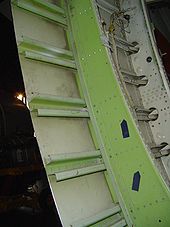Fuselage



The fuselage is a main assembly of an aircraft . It combines all other components of an aircraft, such as structural and tail , the nose landing gear and - if it is not appropriate under the wings - the main landing gear. The fuselage contains the cockpit and the space for passengers and payload . Usually there is also ventilation and air conditioning technology, lubricant tanks and some of the fuel tanks in the fuselage.
shape
The aircraft fuselage is manufactured in various external shapes. This form also depends on the intended use. Cargo aircraft without a pressurized cabin often have a more rectangular cross-section because of the better loading options. Passenger planes usually have a pressurized cabin . The air pressure in the cabin (internal pressure) is higher than that of the atmosphere at cruising altitude (external pressure). The hull must withstand a pressure difference of up to 0.7 bar . A round or oval cross-section has a better distribution of the overpressure forces than an angular one; this is one reason passenger aircraft developers choose one.
Since the fuselage contributes significantly to the overall air resistance of an aircraft, an aerodynamic shape is important for it. The transition from the aircraft fuselage to the wing , especially the wings , is called the fuselage-surface transition . Its shape influences the aerodynamic quality of an aircraft.
construction
So far, the supporting structure of small aircraft has been provided with an outer skin. Here, too, the state of the art is the complete hull as a monocoque , i.e. H. as a supporting shell.
In the early years of aviation, aircraft fuselages consisted primarily of wooden or tubular frames as a supporting structure, which were covered with cloth. As the airspeed and the strength requirements increased, the hulls were later planked with metal, but the supporting structure was still preserved. In June 1918, the Dornier works , the Dornier-Zeppelin DI, designed an aircraft fuselage in half-shell construction to save weight and increase strength for the first time . The fuselage skin is included as a force-absorbing element; it is reinforced by shaping ribs in cross-section and lengthways by stringers . Modern passenger planes are also built in this way. Special reinforcements must be added for windows and doors.
The trend has been towards lighter materials for a long time . In addition to aluminum, newly developed aluminum-lithium alloys and fiber composite materials as well as combinations thereof ( glass fiber reinforced aluminum ) are used. Their advantage lies in their high integrability and lightweight construction potential . The main joining process is still riveting . Other methods are gluing and laser welding .
Variable length
A stretching (lengthening) and shortening of the aircraft fuselage of a basic version is planned from the outset when redesigning and developing commercial aircraft in order to be able to offer different transport capacities. Examples are the Airbus A340 family and Boeing 737 and the Airbus A318 , Airbus A319 and Airbus A321 based on the Airbus A320 . The wings and drives are also economically coordinated here.
Number of hulls
- Flying wings essentially manage without a fuselage.
- The rule are airplanes with a central and longitudinally oriented fuselage, the altitude of which can be partially above or completely below the wing. ( Double and multiple Decker would be considered separately. This did not consider hydrofoils have the body well above the wing.)
- Few types of war aircraft in World War II had two fuselages, each of which had an integrated engine. E.g. North American F-82 .
- If a particularly large payload, such as B. the Space Shuttle or SpaceShipOne , mounted piggyback over an aircraft fuselage, aerodynamically similar to a second fuselage.
- The concept of The Roc from Stratolaunch Systems has 2 fuselages next to each other, on the one hand to take up the payload in the middle (like a third fuselage) and on the other hand to distribute the dead weight more evenly over the particularly large wingspan of the wing.
- Depending on how you look at it, the Lockheed XP-58 Chain Lightning can be viewed as 1-, 2- or 3-hulled, as can the Blohm & Voss BV 138 flying boat .
- There is at least one type of multiply connectable model electric glider. In 2017 a five-fuselage combination flew in Tyrol.
Interior of a Boeing 747 (museum)
Inside view of the fuselage of a Fisher FP-202 ; a frame made of wood, covered with fabric
Tail section of an Airbus A340
literature
- Adolf Beck (Hrsg.): Magnesium and its alloys. Springer Verlag Berlin Heidelberg, Berlin Heidelberg 2001, ISBN 978-3-642-62582-4 .
- Horst Kossira: Basics of lightweight construction. Springer Verlag Berlin Heidelberg, Berlin Heidelberg 2001, ISBN 978-3-642-64846-5 .
Web links
- A new design concept for a CFRP aircraft fuselage (accessed on March 7, 2016)
- Construction methods, materials and production processes ( Memento from March 7, 2016 in the Internet Archive ) (accessed on March 7, 2016)
Individual evidence
- ↑ GREAT SHOW with LOOPING A 5 added RADIAN to ONE HUGE RADIAN and controlled by 4 x PILOTS very nice Modellpilot.EU, youtube.com, upload August 15, 2017, accessed August 22, 2017. - Video (9:04 am).


